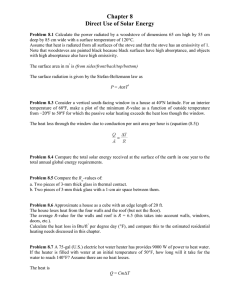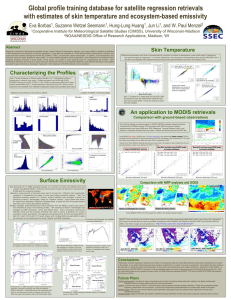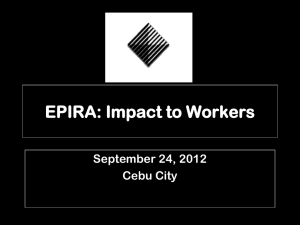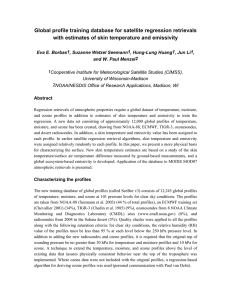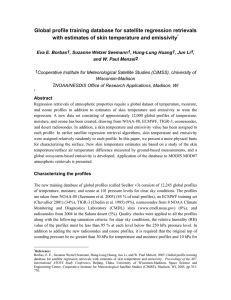PCA and surface emissivities
advertisement
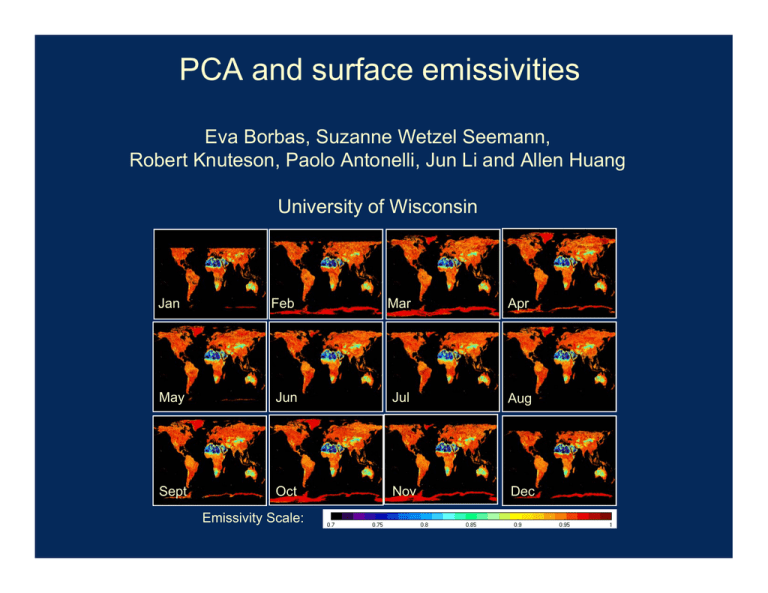
PCA and surface emissivities Eva Borbas, Suzanne Wetzel Seemann, Robert Knuteson, Paolo Antonelli, Jun Li and Allen Huang University of Wisconsin Jan Feb Mar Apr May Jun Jul Aug Sept Oct Nov Dec Emissivity Scale: MODIS, GOES, and radiosonde TPW (mm) Applications Emissivity sensitivity test on MOD07 TPW products All Allcases: cases:bias bias== -0.04mm, 1.90mm, 2.12mm, rms rms == 2.49mm, 3.76mm, 4.33mm, nn == 313 313 Dry Drycases: cases:bias bias== =-0.68mm, 0.32mm, 0.32mm, rms rms == 1.96mm, 2.42mm, 1.97mm, nn == 201 201 Wet Wetcases: cases:bias bias==1.12mm =4.73mm, 5.36mm,,rms rms==5.71mm, 3.22mm, 6.47mm,n= n =112 112 Emis==0.95 version A Emis 1.0 Microwave radiometer TPW (mm) Comparison of total precipitable water (mm) at the ARM SGP site from Terra MODIS (red), GOES8 and -12 (blue), and radiosonde (black), with the ground-based ARM SGP microwave radiometer for 314 clear sky cases from 4/2001 to 8/2005. Average BT differences over all training profiles by ecosystem for all IR MODIS bands with wavelength greater than 4.3 μm We need: A gridded, global surface emissivity database at high spectral and high spatial resolution We have: • MODIS MOD11 emissivity, but only at 6 wavelengths (only 4 distinct wavelength regions): 3.7, 3.9, 4.0, 8.5, 11, 12 μm • Laboratory measurements (UCSB, Dr. Wan, MODIS land team) of emissivity at high spectral resolution, but not necessarily representative of the emissivity of global ecosystems as viewed from space MOD11 Band 29 (8.5μm) emissivity: Monthly averaged October 2003 Approach A: Adjust a laboratory-derived “baseline emissivity spectra” (BES) based on the MOD11 values for every global latitude/longitude pair. Dataset available: http://cimss.ssec.wisc.edu/iremis/ Paper will be submitted soon: Seemann et al.: Infrared global emissivity estimates for clear sky atmospheric regression retrievals Using Principal Component Analysis to get high spectral resolution emissivity database Approach B 1. Selection of laboratory measurements (322) and interpolate them into 413 wavenumbers, with resolution 5 cm-1 2. Compute eigenvectors of lab spectra 3. Choose the number of PCs (30) for >0.999 explained variance 4. Create coefficients for 10,000 (also 20,000 and 200,000) simulated spectra randomly. Ci,npc = Xi,npc • λnpc 5. Filter out the spectra with values larger than 1: this leaves approximately half of original. 6. Find the best-fit simulated spectra globally for each MOD11 emissivity spectra by using a least squares method. The laboratory measurements were convolved with the MODIS SRF before hand. The retrieved emissivities: •Are linear combinations of Lab high resolution emissivity spectra •Match the MOD11 data for the 6 MODIS available (emissivity) channels •Allow for determination of which lab spectra are actually contributing to the retrieved values (back tracing) •Have high spatial resolution (MODIS resolution) and can be validated with AIRS data •Drawback: Laboratory data may not be representative of actual ecosystems as seen from space, uncertainty in regions between MOD11 wavelengths. Mean absolute difference between the original emissivity and that reproduced using the first 9, 25, and 69 principal components (blue, red, and black, respectively). The number of PCs was chosen to represent 0.99, 0.999, and 0.9999 fraction of the total variance. npc=2 npc=3 npc=4 npc=5 npc=6 npc=15 npc=30 npc=413 npc=1 Simulated spectra Lab spectra After screening for > 1 Grid B Aqua 2003 – 8.3μm Jan Feb Mar Apr May Jun Jul Aug Sept Oct Nov Dec Emissivity Scale: Histogram of least squares minimum differences with different number of simulated spectra N10000_4861 N20000_9580 N100000_48102 Approach C Step 1: assumption ε(νh)=c* u (νh) νh u(νh) (eq. 1) is the vector of high resolution wavenumbers is the first n eigenvectors of the laboratory measurements (332,413) Step 2: calculate regression coefficients ε(ν)=c* SRF⊗u (νh) ν ε(ν) c SRF⊗e (νh)=A for each MODIS pixel is the vector of wavenumbers for the 6 MODIS channels MODIS emissivity [6] Regression coefficient [n] the matrix of the first n eigenvectors convolved with MODIS SRF c= ε(ν)*AT(AAT) -1 Step 3: apply C to (eq. 1) Comparison of emissivity spectra using different number of PCs over the area of Amazon (400X400 grid points), August 2003 Red - MOD11 emissivity Blue - Version C emissivity npc=3 npc=5 npc=4 npc=6 Comparison of emissivity spectra using different number of PCs over the area of Nile Delta, August 2003 npc=3 npc=5 npc=4 npc=6 Version A Version B 8.3 μm August 2003 Version C Version A Version B 4.3 μm August 2003 Version C Version A Version B 10.8 μm August 2003 Version C Version A Version B 4.3 μm Version C August 2003 Version A Version B 8.3 μm Version C August 2003 Version A Version B 10.8 μm Version C August 2003 Comparison A & B & C SGP Cart Site Sahara desert Comparison of emissivity spectra derived by the Version A baseline fit method (red), the Version B PCA/MOD11 matching method (black) and the PCA/MOD11 regression method (blue) for the ARM SGP site in Oklahoma (left), and a Sahara desert location (Lat: 23.5N, Lon: 30.0E) (right). Dave Tobin and Bob Knuteson’s best estimate emissivity spectra (blue) is also plotted over the ARM site (left panel). Future Plans • Investigate the problems: – emissivity greater than 1 (version C) – experiments with different number of PCs (version C) – discontinuous emissivity fields (version B) • Apply similar techniques using AIRS retrieved emissivity spectra • Validation, validation, validation - we are looking for any available measurements to compare with (evab@ssec.wisc.edu) • Continue to evaluate the impacts of an improved surface emissivty value on retrieved MODIS and AIRS products

